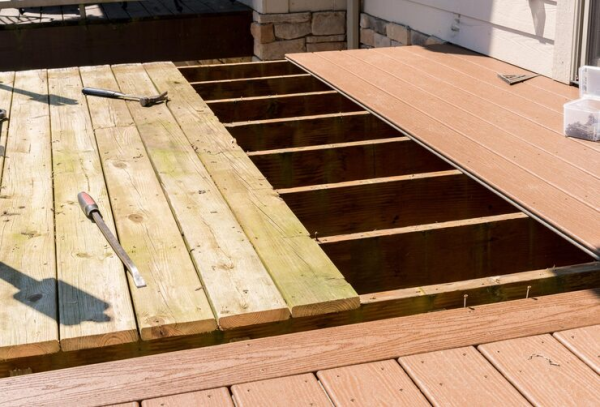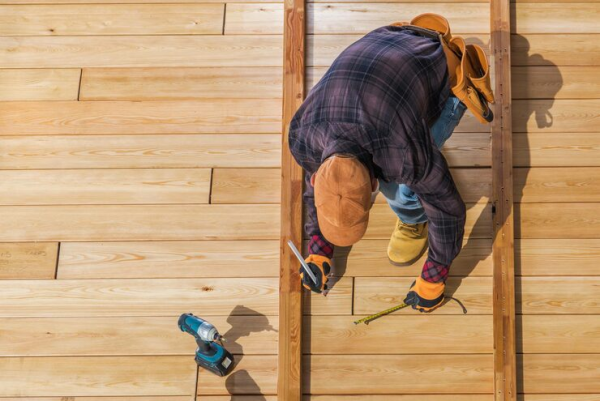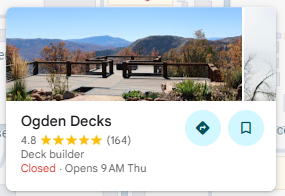Experts Reveal the Most Inexpensive Way to Build a Deck
The most inexpensive way to build a deck is by choosing a simple ground-level design, which avoids the need for costly foundations, railings, and complex framing. Pressure-treated lumber is the most budget-friendly material, while keeping the layout basic—like a square or rectangle—further reduces expenses. Homeowners can save more by handling DIY staining, shopping around for materials, or starting small and adding features later. While a DIY approach can cut labor costs, hiring professionals like Ogden Decks ensures safety, efficiency, and lasting quality. With proper maintenance such as sealing, cleaning, and yearly inspections, even a budget-friendly deck can last for decades, offering extra living space, higher home value, and a cozy outdoor retreat without overspending.
Utah, USA, United States, 24th Sep 2025 – If you’ve been dreaming of creating a cozy outdoor living space without breaking the bank, you’re not alone. Decks are one of the most desirable features homeowners add to their property, offering both style and functionality. But here’s the catch: depending on the design, materials, and extras, the price of building a deck can climb quickly. That leads many people to ask the all-important question: what is the most inexpensive way to build a deck?
The good news is that with thoughtful planning, material selection, and design choices, you can build a beautiful, functional deck that doesn’t drain your savings. And one of the simplest and most cost-effective solutions is building a ground-level deck. Let’s explore why this option is budget-friendly and how you can make smart choices to keep costs low while still enjoying a stunning outdoor retreat.

Why Build a Deck in the First Place?
Before diving into cost-saving strategies, it’s worth understanding why a deck is such a valuable addition to your property:
- Adds Living Space: A deck extends your home’s living area outdoors, perfect for entertaining guests, grilling, or simply relaxing.
- Increases Home Value: Even a modest deck can boost curb appeal and attract potential buyers if you ever decide to sell.
- Customizable Design: From small, functional platforms to larger multi-tiered decks, you can create a layout that fits your lifestyle and budget.
- Connects You to Nature: A deck makes it easier to enjoy your yard, garden, and the natural surroundings without stepping directly into the dirt.
The challenge, however, is how to enjoy these benefits while keeping costs manageable.
The Case for a Ground-Level Deck
A ground-level deck is exactly what it sounds like: a platform-style deck built low to the ground, typically without the need for stairs, railings, or complicated support structures.
Here’s why it’s the most inexpensive option:
- No expensive foundation: Elevated decks require posts, concrete footings, and extra support beams. Ground-level decks can be placed on simple blocks or directly on leveled ground, cutting labor and material costs significantly.
- No railing requirements: Building codes often require railings for decks higher than a certain height. Staying low means you don’t need to spend money on railings.
- Simpler construction: Without stairs or complex framing, building a ground-level deck is faster and requires fewer materials.
- Flexible placement: Since it doesn’t need to be attached to your house, you can place it anywhere in your yard—by a garden, under a shady tree, or near a pool.
The result is a cozy, affordable outdoor living space that serves its purpose without the high price tag.
Choosing the Right Materials on a Budget
Material selection is one of the biggest factors influencing deck cost. Here are the most common options, ranked by affordability:
1. Pressure-Treated Lumber
- Pros: By far the cheapest option, pressure-treated wood is widely available and durable when maintained properly.
- Cons: Requires regular staining or sealing to prevent rot, warping, and insect damage.
2. Cedar or Redwood
- Pros: Naturally resistant to insects and decay, these woods are attractive and long-lasting.
- Cons: More expensive than pressure-treated lumber, though often less costly than composite materials.
3. Composite Decking
- Pros: Made from recycled materials, composites are low-maintenance and resist rot and fading.
- Cons: Higher upfront cost, though long-term maintenance savings can balance this out.
4. Pallet Wood or Repurposed Materials
- Pros: Ultra-budget-friendly if sourced locally or free. Adds a rustic, creative look.
- Cons: Not as durable, often uneven, and may require extra sanding or sealing.
Tip: For the lowest cost upfront, pressure-treated lumber is your best choice. If you’re willing to invest a little more for reduced upkeep, consider composites.
Simplifying the Design
Design complexity directly affects the overall budget. If you want inexpensive, keep it simple:
- Stick to a Rectangle or Square: Curves and custom shapes require more cutting and wasted material.
- Single-Level Design: Multi-tiered decks look great but double or triple costs.
- Skip Built-In Features: Benches, planters, and pergolas add beauty but also expense.
- DIY Staining Instead of Exotic Wood: A simple stain or paint job can give your deck the look of pricier materials.
The bottom line: simple shapes, fewer extras, and clean lines equal lower costs.
Where to Save vs. Where to Spend
If you’re building on a budget, you’ll want to decide where cutting costs makes sense and where it’s better to invest.
- Save On:
- Design complexity (keep it straightforward).
- Labor (consider a DIY approach if you’re handy).
- Unnecessary extras (skip railings, stairs, or built-in features for now).
- Spend On:
- Quality materials for the deck surface (cheap wood that rots fast costs more long-term).
- Proper sealing and protection to extend deck life.
- A solid foundation—even ground-level decks need stability.
Balancing savings with smart investments ensures you get the most value for your money.
DIY vs. Professional Help
Building a small ground-level deck can be a doable project for skilled DIYers. However, there are trade-offs:
- DIY Pros: Saves on labor costs, full control of the project, personal satisfaction.
- DIY Cons: Time-intensive, requires tools and carpentry skills, mistakes can be costly.
Hiring professionals ensures:
- Safety: A professionally built deck meets building codes and lasts longer.
- Efficiency: Professionals work faster and minimize errors.
- Customization: Skilled builders can design a deck that balances affordability with aesthetics.
If your goal is saving money, a DIY build may work—but for a long-lasting, safe deck, hiring a professional like Ogden Decks often pays off in the long run.

Budget-Friendly Tips for Building Your Deck
Here are additional tips to keep costs low:
- Shop Around for Materials: Prices vary between suppliers, especially during sales or seasonal clearances.
- Consider Deck Kits: Pre-cut kits can simplify the process and reduce waste.
- Use Gravel Instead of Concrete Footings: For ground-level decks, gravel pads may be sufficient and cheaper.
- Plan for Future Upgrades: Start with a basic deck and add features like railings, lighting, or pergolas later when your budget allows.
- Do Your Own Staining or Painting: This is a simple DIY task that can save hundreds of dollars.
Creating Your Own Backyard Oasis
One of the biggest advantages of a ground-level deck is flexibility. Unlike an attached elevated deck, a ground-level platform can be placed anywhere in your yard. Imagine creating:
- A garden oasis with seating surrounded by flowers.
- A poolside lounge for summer relaxation.
- A cozy firepit area for family evenings outdoors.
- A quiet reading nook under a shady tree.
With thoughtful placement, your inexpensive deck can feel like a luxurious retreat without the luxury price tag.
Long-Term Maintenance: Protecting Your Investment
Even a budget-friendly deck requires care. To extend its life:
- Seal or stain wood regularly: Protects against moisture, rot, and UV damage.
- Clean debris often: Sweep leaves and dirt to prevent mold or stains.
- Check for damage yearly: Replace loose boards, nails, or screws before they cause bigger issues.
- Cover during off-season: Using a tarp or patio cover can extend lifespan.
Maintenance is the difference between a deck that lasts five years and one that lasts twenty.
Conclusion: Build Smart, Spend Less
The most inexpensive way to build a deck is by choosing a ground-level design. Not only does it save on materials like posts, railings, and stairs, but it also offers flexibility in placement and simplicity in construction. Pairing this with budget-friendly materials like pressure-treated wood and a straightforward design ensures you create a beautiful space without overspending.
If you’re ready to bring your deck vision to life, Ogden Decks can help you strike the perfect balance between affordability and quality. Whether you’re dreaming of a simple ground-level retreat or planning future upgrades, our team is here to design and build a deck tailored to your needs and budget.
Call us today at +1 801-528-9807 and let’s start building your perfect outdoor space.
Ogden Decks
190 W 33rd St, Ogden, UT 84401, United States
+18015289807
Company Details
Organization: Ogden Decks
Contact Person: Ogden Decks
Website: https://www.ogdendecks.com/
Email: Send Email
Contact Number: +8015289807
Address: 190 W 33rd St, Ogden, UT 84401, United States
City: Utah
State: USA
Country: United States
Release Id: 24092534028

